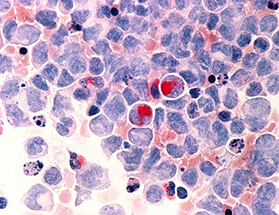
Researchers have found that UTY, a gene on the Y chromosome, protects male mice lacking the tumour-suppressing UTX gene on the X chromosome from developing acute myeloid leukaemia.
Scientists have discovered the first leukaemia protective gene that is specific to the male-only Y chromosome. Researchers at the Wellcome Sanger Institute, the Wellcome-MRC Cambridge Stem Cell Institute and the CRUK Cambridge Centre Haematological Malignancies Programme found that this Y-chromosome gene protects against the development of Acute Myeloid Leukaemia (AML) and other cancers.
The research, funded by Bloodwise, Cancer Research UK, Wellcome, ERC, the Kay Kendall Leukaemia Fund and others was published in Nature Genetics and investigated how loss of the X-chromosome gene UTX, which is known to be mutated in many tumours, hastens the development of AML. However, they found that UTY, a related gene on the Y chromosome, protected male mice lacking UTX from developing AML. The authors then show that in AML and in several other human cancers types, loss of UTX is accompanied by loss of UTY, confirming that the cancer-suppressing role of UTY extends beyond AML.
Acute myeloid leukaemia is an aggressive blood cancer that affects people of all ages. It develops in stem and progenitor cells in the bone marrow and leads to life-threatening infections and bleeding. Mainstream AML treatments have remained unchanged for decades and fail to cure the majority of patients who die from the disease.
Women have two X chromosomes whereas men have one X and one Y chromosome. The X and Y chromosomes share many genes, but a small number of genes, including UTY, are only found on the Y chromosome. These Y-specific genes were thought to contain the genetic information required for male sexual characteristics, but were not known to have other roles. The discovery of this new role changes the way the Y chromosome is viewed and improves our understanding of how AML and other cancers develop.
Professor Brian Huntly, joint project leader and a Haematological Malignancies Programme Lead at the CRUK Cambridge Centre (Wellcome-MRC Cambridge Stem Cell Institute, and Consultant Haematologist, at Cambridge University Hospitals NHS Trust) said: “It is known that men often lose the Y chromosome from their cells as they age, however the significance of this was unclear. Our study strengthens the argument that loss of the Y chromosome can increase the risk of cancer and describes a mechanism for how this may happen.”
In their study, researchers studied the UTX gene in human cells and in mice to try to understand its role in AML. In addition to their discovery that UTY acts as a tumour suppressor gene, the scientists found a new mechanism for how loss of UTX leads to AML. They discovered that UTX acts as a common scaffold, bringing together a large number of regulatory proteins that control access to DNA and gene expression, a function that can also be carried out by UTY. When UTX/UTY are missing, these proteins can’t regulate gene expression correctly and cancer growth becomes more likely.
Dr George Vassiliou, joint project leader and Haematological Malignancies Programme Member from the Wellcome Sanger Institute, Wellcome-MRC Cambridge Stem Cell Institute and Consultant Haematologist at Cambridge University Hospitals NHS Trust said:
“Treatments for AML have not changed in decades and there is a large unmet need for new therapies. This study helps us understand the development of AML and gives us clues for developing new drug targets to disrupt leukaemia-causing processes. We hope this study will enable new lines of research for the development of previously unforeseen treatments and improve the lives of patients with AML.”
For full details, please read the full article at: Malgorzata Gozdecka et al. (2018) UTX-mediated enhancer and chromatin remodeling suppresses myeloid leukemogenesis through noncatalytic inverse regulation of ETS and GATA programs. Nature Genetics. DOI: 10.1038/s41588-018-0114-z















